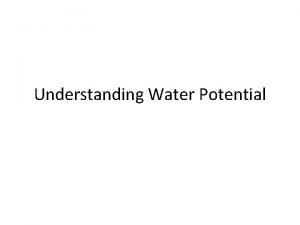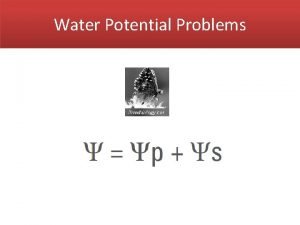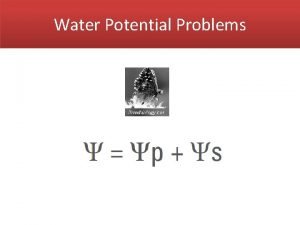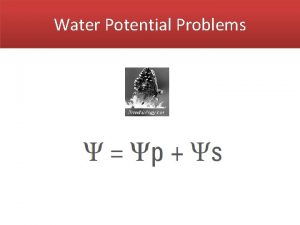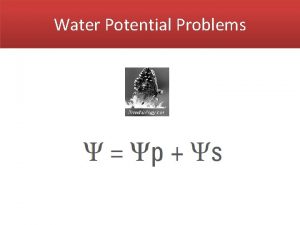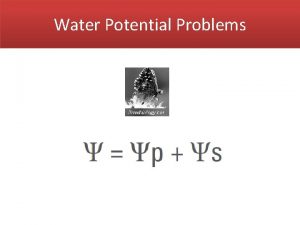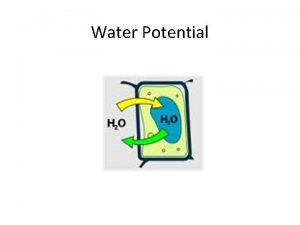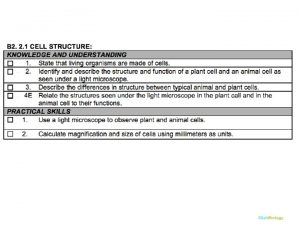Click Water potential is a concept that helps

















- Slides: 17

Click

Water potential is a concept that helps to describe the tendency of water to move from one area to another, particularly into or out of cells. o. Water molecules move randomly. o. When water is enclosed by a membrane some of the moving water molecules will hit the membrane, exerting pressure on it. o. This pressure is known as water potential.

ØIt is measured in units of pressure, can be measured in k. Pa, MPa, bar. ØPure water has a water potential of zero. ØA solution will have a lower concentration of water molecules so it will have a negative water potential.

Water Potential • We look at water movement in terms of water potential. (ψ psi) • Two factors: – Solute concentration and pressure • Pure water ψ =0 • The addition of solute lowers the water potential. (negative number) Water potential determines the rate and direction of osmosis.

ψp v. Pressure potential is important in plant cells because they are surrounded by a cell wall which, is strong and rigid. ψp v. When water enters a plant cell, its volume increases and the living part of the cell presses on the cell wall. ψ v. The cell wall gives very little and so pressure p starts to build up inside the cell. v. This has the tendency to stop more water entering the cell and also stops the cell from bursting. v. When a plant cell is fully inflated with water, it is called turgid v. Pressure potential is called turgor pressure in plants) ψp

Water potential (ψ ) = pressure potential (ψp ) + solute (osmotic) potential (ψs) Pressure potential ( Solute potential ( ψp): ψs): In a plant cell, pressure exerted by the rigid cell wall that limits further water uptake The effect of solute concentration. Pure water at atmospheric pressure has a solute potential of zero. As solute is added, the value for solute potential becomes more negative. This causes water potential to decrease also. *As solute is added, the water potential of a solution drops, and water will tend to move into the solution.

Water moves from a place of high water potential to a place of low water potential. Water potential (ψ) = pressure potential (ψp ) + solute potential (ψs) (osmotic) This is an open container, so the ψp = 0 This makes the ψ = ψs The ψs =-0. 23, so ψ is -0. 23 MPa, and water moves into the solution.



ØCan a solution with a molarity of 0. 2 be in equilibrium with a solution with a molarity of 0. 4? ØYES! ØPressure ØTwo solutions will be at equilibrium when the water potential is the same in both solutions. This does not mean that their solute concentrations must be the same, because in plant cells the pressure exerted by the rigid cell wall is a significant factor in determining the net movement of water.

Solute (osmotic) potential (ψs )= –i. CRT i = The number of particles the molecule will make in water; for Na. Cl this would be 2; for sucrose or glucose, this number is 1 C = Molar concentration Yikes, what's that? ? ? R = Pressure constant = 0. 0831 liter bar/mole K T = Temperature in degrees Kelvin (273 + °C) of solution Example Problem: The molar concentration of a sugar solution in an open beaker has been determined to be 0. 3 M. Calculate the solute potential at 27°C degrees. Round your answer to the nearest hundredth. What is the water potential? Answer: -7. 48 Solute potential = -i. CRT = -(1) (0. 3 mole/1) (0. 0831 liter bar/mole K) (300 K) = -7. 48 bar Water potential = -7. 48 + 0, so water potential = -7. 48

Let’s Take a class quiz!!

click So, we can now define osmosis as the movement of water molecules from a region of higher water potential to a region of lower water potential through a semi-permeable membrane.

Molarity Another way of expressing concentration, the way that we will use most in this course, is called molarity. Molarity is the number of moles of solute dissolved in one liter of solution. The units, therefore are moles per liter, specifically it's moles of solute per liter of solution.

Be very careful to distinguish between moles and molarity = moles of solute liter of solution "Moles" measures the amount or quantity of material you have; "molarity" measures the concentration of that material. So when you're given a problem or some information that says the concentration of the solution is 0. 1 M that means that it has 0. 1 mole for every liter of solution; it does not mean that it is 0. 1 moles

What is the molarity of a solution made by dissolving 2. 5 g of Na. Cl in enough water to make 125 ml of solution? molarity = moles of solute liter of solution 2. 5 g Na. Cl x 1 mole of any substance has a mass = to the atom’s atomic mass. 1 mole Na. Cl 58. 5 g Na. Cl molarity = = 0. 0427 mole Na. Cl 0. 125 L = 0. 34 M Na. Cl Molarity is number of moles per Liters of solution

EXAMPLE PROBLEMS 1 - An AP Biology student dissolves 98. 4 g of Fe. SO 4 in enough water to make 2. 000 L of solution. What is the molarity of the solution? 0. 324 M 1 mole. 151. 91 g x 98. 4 g = 0. 647 moles ÷ 2. 00 L= 0. 324 mol/L 151. 91 g Return to Water Potential Discussion
 Click clever click safe
Click clever click safe E safety
E safety Clever click
Clever click Click clever click safe
Click clever click safe Water and water and water water
Water and water and water water Flaccid cell
Flaccid cell Water potential in plant cells
Water potential in plant cells Osmotic potential vs water potential
Osmotic potential vs water potential Osmotic potential vs water potential
Osmotic potential vs water potential Phân độ lown
Phân độ lown Block nhĩ thất cao độ
Block nhĩ thất cao độ Thể thơ truyền thống
Thể thơ truyền thống Thơ thất ngôn tứ tuyệt đường luật
Thơ thất ngôn tứ tuyệt đường luật Chiến lược kinh doanh quốc tế của walmart
Chiến lược kinh doanh quốc tế của walmart Tìm vết của đường thẳng
Tìm vết của đường thẳng Con hãy đưa tay khi thấy người vấp ngã
Con hãy đưa tay khi thấy người vấp ngã Tôn thất thuyết là ai
Tôn thất thuyết là ai Gây tê cơ vuông thắt lưng
Gây tê cơ vuông thắt lưng




















